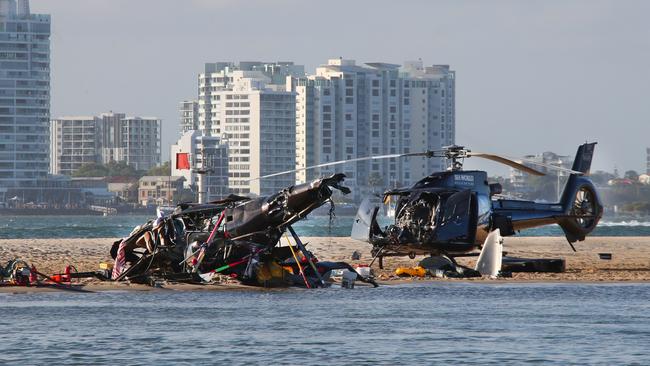SeaWorld helicopter crash pilot didn’t hear from other chopper, report finds
A pilot in a mid-air crash did not hear a crucial radio call from the other chopper nor did he see it take off, investigators have found.

A helicopter pilot involved in a mid-air collision with another chopper at Sea World in January did not receive a crucial radio call, an Australian Transport Safety Bureau report has found.
The ATSB has released its preliminary report on the tragedy, which killed four people including Sea World Helicopters chief pilot Ashley Jenkinson, British couple Diane and Ron Hughes and Sydney mother Vanessa Geagea Tadros.
The crash occurred as one helicopter XH9 was coming into land and another, XKQ, was departing its helipad on a scenic flight.
The distance between the two helipads at the Sea World theme park was 220m.
The incoming helicopter was flown by pilot Michael James who told the ATSB he had a clear view of the helipads as he returned from a short flight with five passengers on board.
“The pilot of XH9 stated that while transiting the Broadwater, they saw passengers being loaded into (the other helicopter) XKQ and the doors of XKQ closing,” the report said.
“The pilot of XH9 recalled that their assessment at the time was that they would be clear of XKQ and that it would pass behind them.”
Moments later XKQ began its flight and Mr James reported he “did not hear a taxiing call over the radio from the pilot of XKQ”.
ATSB chief commissioner Angus Mitchell said that didn’t mean there wasn’t a taxiing call made by the other pilot, Mr Jenkinson.
“The radio traffic was recorded from the Southport tower, which is some distance from (Sea World) and we do know that calls made at low altitude are not routinely picked up by that recording,” said Mr Mitchell.
“That’s why we would can’t say that call wasn’t made, we just don’t have the evidence at this stage.”
Mr James also told the ATSB he did not see XKQ depart from the helipad and as his helicopter turned to make its final approach, he reported being focused on the landing site.
On board the helicopter, passengers saw the approaching aircraft and tried to alert Mr James verbally and then physically by tapping his shoulder.
“The pilot of XH9 (Mr James) later recalled being alerted to the other helicopter by a passenger but the pilot did not see XKQ approaching prior to the collision.”
Within 23-seconds of XKQ taking off, the two helicopters collided at a height of about 130-feet (40m).
The report said the main rotor blades of XKQ entered the forward cabin of XH9, and XKQ broke apart in mid-air and crashed into shallow water.
The pilot Mr Jenkinson, and three passengers were killed while three other passengers were seriously injured.
The other helicopter was able to land, despite serious injuries to the pilot and two passengers. Three passengers had minor injuries.
Mr Mitchell said the ATSB was conducting a “systemic investigation” which meant they looked well beyond the events of the accident itself.
“We are looking at organisational influences. We’re potentially looking at things far greater than what occurred on January 2,” he said.
Numerous witness statements and “a dozen different video angles” of the crash, were assisting the ATSB investigation, he said.
Although the radio call was important, Mr Mitchell denied it was critical to the outcome of the investigation.
“We can only rely on the evidence we receive and in some instances we don’t have all of the evidence but we do have a lot in this particular instance, so I’m confident we will find some systemic issues that potentially can be addressed to improve safety in this type of operation,” he said.
The final report was expected to take another 18-months to two-years to complete, with the families of those involved in the crash to be kept informed along the way.
“Those who lost a loved one in this accident and the survivors who are still recovering want to understand how the tragedy unfolded and why it occurred, and why the safety equipment, processes and procedures did not work on this occasion,” said Mr Mitchell.
“That’s the ATSB’s purpose, to uncover any safety issues that contributed.”
Further investigations by the ATSB would focus on witness videos and images, interviews with the surviving pilot and ground crew, and a review of the operators’ procedures.
To date the operator, SeaWorld Helicopters, has committed to improving aircraft visibility through high visibility paint on rotor blades and additional strobe lighting on helicopters.
The company has not flown since the crash.




To join the conversation, please log in. Don't have an account? Register
Join the conversation, you are commenting as Logout